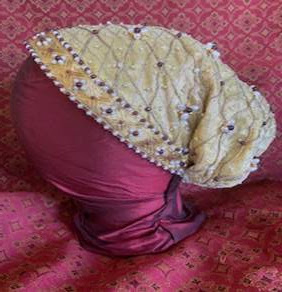Category: With scarfs, and fans, and double change of bravery, With amber bracelets, beads, and all this knavery. An accessory your persona may have owned, made, used, or gifted.

Purpose:
There are many hats in the Portuguese paintings of the 1520s, in particular they are seen all over the St Auta Altarpiece where many of the female figures are wearing a relation of a flat cap. The hat I particularly liked was in Gregorio Lopes’s Visitation painting as it was well blinged up! I had already made a version of the pink dress for the Baronial A&S Championship and made a version of the hat but it wasn’t quite right so I wanted to make one that was more in keeping with the portrait. I spent a long time staring at the image to get a sense of what was happening with this hat and talked to Mistresses Isabel Maria and Cristia about it. The consensus was that it was a kind of split brim arrangement that was sewed up on to the side of the hat. Much paper was used to get a sense of how it worked.

Materials used:
- A $2 shop pirate hat. By taking the pirate fabric off it I was left with a ‘felt’ like base
- Black velvet to cover the hat and make the folds on the hat. I picked velvet as many of the St Auta hats look like they are made from velvet as does the one in the image above.
- Pearl and gold buttons – I managed to get the same design in two different sizes. While there aren’t pearls on the hat in the image I like them and the buttons were the most appropriate looking ones I found
- Pearl and gold bead aglets that I made myself using some oval shaped gold beads, plastic pearls and earring pins. I decided to interpret the spiky bits on the hat as aglets as they are a common feature of 16th century hats. Using the pearl and gold beads allowed me to match the buttons too!
- A vintage filigree ‘gold’ and pearl brooch
- A very small amount of gold silk to line the split brim
- Black thread and a robust needle
Methods used:
- I cut out a round of black velvet a little bigger than the hat base and ran a gathering stitch around the edges of the circle.
- I pulled the gathering stitch so the material fitted over the round of the hat and hand sewed it to the inside of the hat.
- I made a 10cm strip with black velvet on one side and the gold silk on the other. I sewed this on the machine for ease of use.
- I cut this strip into six panels that were long enough that when pressed flat against the hat reached the top of the brim and folded over the edge of the hat base. These were sewed inside the hat all the way around the hat with cuts in the edge so they sat flat.
- In the gap between each panel of velvet and silk I sewed three buttons with a big one in the middle and two smaller ones on either side.
- I made the aglets out of earring wires and beads and used my pliers to create loops in the wire.
- I sewed these aglets in fours on either side of the middle button
- I hand sewed the gold brooch it was on the front side of the hat like in the original image.



Verdict:
It is so pretty and much more in keeping with the portrait than my first attempt. I didn’t count on there being so much bulk inside the hat with the edges of the panels sewing into it so it doesn’t fit quite as comfortably as I would prefer but it still works.
Additional images
- Check out the St Auta altarpiece here – https://www.wikidata.org/wiki/Q28680322
- The full version of the Lopes and Leal Visitation painting can be found here – https://pt.wikipedia.org/wiki/Visita%C3%A7%C3%A3o_(Greg%C3%B3rio_Lopes_e_Jorge_Leal))














